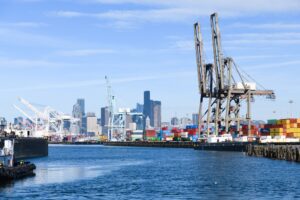Ten Quick Wins for: Re-globalization and Resilience in Trade

The year 2024 marks a global election cycle with over 80 countries, representing more than half of the world’s population casting their votes. In these uncertain times, the world finds itself confronted by a state of “polycrisis”—a complex web of interconnected global challenges that transcends borders. Geopolitics and international trade have a critical role to play in driving solutions to these crises.
As many countries continue to navigate the aftermath of the COVID-19 pandemic, the world contends with other pressing issues such as the increasing urgency of tackling climate change and addressing the fragmentation of traditional geopolitical alliances. As nations confront various stressors, including ongoing conflicts in several regions around the world, these interconnected issues have heightened uncertainties and undermined the previously robust support for open trade.
Consequently, countries are increasingly looking inwards, focusing on reshoring, “friendshoring,” and forming strategic alliances. Amid these shifts, there has been a noticeable backlash against globalization and free market economics, accompanied by a global rise in support for interventionism, a trend showcased by the growing embrace of industrial policy. In this evolving context, trade has emerged as both a strategic instrument and a point of tension, as demonstrated by the simmering trade war between the United States and China, and fragmentation spurred by competition among geopolitical blocs.
These geopolitical maneuvers are reshaping global trade patterns, leading to trade diversion and the formation of new economic relationships. Although the World Trade Organization (WTO) also faces its own crises, it remains a vital platform for promoting international cooperation. For example, to facilitate pathways to cooperation and mitigate economic security risks, the WTO can provide a forum for members to design a mechanism to address economic security concerns while supporting multilateral governance, as one of the report’s authors suggests. At the same time, the focus on securing supply chains and fostering domestic capabilities, particularly in clean technology and critical raw materials (CRMs), underscores the integration of trade and technological advancement. However, alongside a clean tech boom, a wave of protectionism and industrial policy has blossomed in these key industries. The result is a global critical minerals supply chain that discourages responsible actors, presenting security and labor rights concerns.
Ultimately, the promise of a sustainable and interconnected future hinges on international cooperation. The WTO’s current rules on technical barriers to trade can serve as a guide for the development of enforceable mining standards to help mitigate the risks of expanded mining activities while refraining from raising significant trade barriers. Additionally, the organization can take concrete steps to ensure the clean technology boom also leads to clean technology transfer by prioritizing linkages between the trade and climate regimes and their respective technology transfer initiatives. The WTO could also revitalize discussions on reducing barriers to trade for environmental goods (and services), elevating them to top priority.
Across all of these issues, the implications of trade policies for developing countries, particularly workers, remain a critical concern. These countries often face significant challenges in accessing the full benefits of global trade, and are increasingly impacted by unilateral trade measures and trade-related policies. The quest for inclusivity and fairness in trade is crucial for addressing global issues such as climate change, as developing countries often lack the financial resources, infrastructure and technology, and institutional capacity to meet climate targets. Such economic disparity risks the exclusion of developing countries from the benefits of global climate initiatives. Alongside this, re-globalization can leverage trade measures to improve the representation of workers and other groups previously excluded from the design, implementation, and enforcement of trade policies. Addressing gaps in an inclusive trade agenda is essential to ensuring the benefits of trade are more equally distributed across developing countries and vulnerable stakeholders, including women.
TradeExperettes_10+Quick+Wins+for+Re-globalization+and++Resilience+in+Trade+FINAL-compressed09/09/2024 | María Belén Gracia, Euijin Jung, Inu Manak, Penelope Ridings & Elizabeth Whitsitt | TradeExperettes
Building Resilient Supply Chains: The Case of Semiconductors

After decades of globalization and relative stability, the world is at a turning point. Amidst rising geopolitical tensions, shifting supply chains and states’ embrace of national industrial strategies, policy and corporate decision makers are facing a host of new, challenging questions concerning technologies, markets, and supply chains crucial to economic and national security. These critical and emerging technologies are increasingly and intimately intertwined with geopolitical frictions, if not at their core. Thus, it is important to recognize today’s unique challenges that require innovative thinking and approaches in technology governance to strengthen and build resilient supply chains that are prepared to withstand and can adapt to new geopolitical dynamics.
Interconnected global supply chains based around comparative advantage and lower labor costs linked through complex logistics have proven to be a key component of globalization. However, the interdependence between economies, and the reliance on even geopolitical rivals, has revealed downsides that go beyond pure economic and efficiency considerations. Disruptions, especially during and after the COVID-19 pandemic, have reinforced the need for states to assess risks across a variety of national industries and global market sectors. These domains range from critical food and medical supplies, to automotive, raw materials and other commodity markets, and especially high-tech supply chains, like in the semiconductor ecosystem. To address the issue of supply chain resilience, this assessment evaluates semiconductors as a case study and discusses the risks of disruptions to the supply chain and the measures governments across the globe have taken individually and collectively to strengthen this crucial industry.
Semiconductors, which underpin nearly all current and near-future technology applications in the commercial and military realms, are a key concern for nations’ economic, security, and foreign policies. Governments have chosen to manage dual-use technologies and their supply chains, including semiconductors, comprehensively through new export controls, tariffs, investment screening, and de-risking through investments, subsidies and international cooperation to mitigate risk from growing geopolitical friction. These efforts are primarily driven unilaterally, but collective action and cooperation will be pivotal to ensuring supply chain resilience moving forward for the United States and its allies and partners.
ORFAmerica_BP26_Chips_Supply_ChainRead the Full Background Paper Here
08/30/2024 | Jeffrey Bean & Andreas Kuehn | Observer Research Foundation America
The Case for a Comprehensive US-EU Economic Agreement

The United States and Europe are currently in political limbo. On one side of the Atlantic, the outcome of the US presidential election in November could go either way. On the other side, the makeup of the new European Commission is yet unclear. But what is certain is that the United States and the European Union (EU) face a range of shared challenges ahead no matter who is at the helm. These challenges include predatory nonmarket economic practices, deindustrialization, supply chain vulnerabilities, the transition to a digital economy, and climate change. Successfully dealing with these issues will require unprecedented transatlantic coordination both to leverage joint power and to avoid causing collateral damage to each other. To that end, policymakers in Washington and in Brussels should begin discussions on the contours of a comprehensive, three-pillar US-EU economic agreement now, so that both sides can hit the ground running in early 2025.
It won’t be easy. Ambitions to broaden and deepen the transatlantic marketplace suffer from past disappointments. The Transatlantic Trade and Investment Partnership foundered in disputes over hormone-treated beef and investor-state dispute settlement. The current EU-US Trade and Technology Council has produced only narrow benefits. In the absence of coordination, both Washington and Brussels have resorted to unilateral measures, such as the US Inflation Reduction Act, national security-related tariffs on steel and aluminum, and the EU’s doubling down on its long-proposed carbon border adjustment mechanism. In the future, the need to take urgent unilateral measures will only increase as the dire consequences of failing to act become clear.
A comprehensive transatlantic economic agreement—not a traditional trade agreement—could avoid relitigating the issues that have sunk past US-EU trade and investment initiatives. Rather, learning from the lessons of past efforts, Washington and Brussels must accept that, despite their shared interests, Europe and the United States have decidedly different economic cultures and polities. And any new comprehensive agreement should accommodate these differences while coordinating parallel approaches to the rapidly evolving global economy.
09/15/2024 | L. Daniel Mullaney & Bruce Stokes | Atlantic Council
How Trade Agreements Have Enhanced the Freedom and Prosperity of Americans
An essential part of America’s turning away from protectionism since the Great Depression has been the signing of free trade agreements (FTAs) with other nations. Those agreements, while imperfect, have led to lower tariffs and other barriers to trade, in the United States and abroad. They also have provided incentives for compliance through dispute settlement while discouraging mutually damaging trade wars. Although the impact of trade agreements has often been exaggerated by both their advocates and opponents, decades of experience and economic analysis confirm that the benefits for most Americans have been positive. The United States today is a richer and freer nation, and the world is a more hospitable place for economic activity because of those trade agreements.
The most straightforward and preferable path to trade liberalization for any country is the unilateral reduction of trade barriers without regard for other countries’ trade policies. Unilateral liberalization allows a country to realize the gains from openness—mainly lower prices for consumers, lower-cost inputs for businesses, and a more favorable exchange rate for exporters—without the need for complicated negotiations with other countries. Many nations have followed this route with success, from Great Britain in the mid–19th century to China and India and other emerging economies since the 1980s. As discussed in a separate Defending Globalization essay, however, unilateral liberalization is politically difficult, so governments have turned to reciprocal trade agreements, which offer reduced trade barriers at home in exchange for similar liberalization among participating governments abroad. The best approach to trade agreement liberalization is multilateral—the lowering of barriers to goods, services, and investment in a nondiscriminatory way by almost all countries through such forums as the World Trade Organization (WTO). A next-best option is bilateral and regional FTAs among two or several governments, respectively.
The United States is a partner in bilateral and regional FTAs with 20 other nations, including such major trading partners as Canada, Mexico, South Korea, Singapore, and Australia. The United States was a founding member of the General Agreement on Tariffs and Trade after World War II and is a member of its successor institution, the WTO, a multilateral agreement with 165 other countries that covers 98 percent of world trade. The United States is also party to narrower bilateral investment treaties with about 40 other nations that protect American investment assets abroad.
The 20 bilateral and regional FTAs that the United States has signed have virtually eliminated tariffs on US exports to those countries. Those FTAs have achieved what even trade populists claim as a goal: reciprocal tariff rate reductions. By definition, FTAs set virtually all tariffs between the signatory nations at zero. The reductions, as well as liberalizing components (restrictions on nontariff barriers, services, and investment disciplines, for example), can be phased in over time, and a few politically sensitive sectors can be excluded, but substantially all trade under the 20 FTAs that the United States has signed occurs duty-free.
08/27/2024 | Daniel Griswold & Clark Packard | Cato Institute


